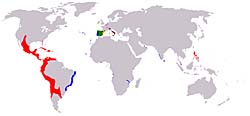
Unit 2: How Trade and Travel Changed the World
Lesson H: Exploration and Contact in the Atlantic
Activity 4: Foreign Customs Meet Native Culture
By the late 1500s, the Spanish and Portuguese had created colonial empires that spanned the globe. Colonization of areas in Africa, India, and Southeast Asia, as well as the Americas, continued from the 16th into the 17th century.
As the map shows, much of North and South America was colonized by Portugal and Spain during the 1500s and 1600s. Prior to colonization, millions of native peoples populated North and South America. The rapid spread of disease, harsh colonial government policies, and warfare between natives and colonizers led to the rapid decline of native populations.
The impact of colonization on the native people of America was huge. It can be seen today in the language, religion, and architecture found throughout Latin America. Still, these characteristics are not purely Spanish or Portuguese. They reflect a blending of cultures. The great changes made to social, political, and economic systems as a result of colonization also led to the exchange and blending of American and European cultures.
In the opening of the lesson you predicted the effects of interaction between native and foreign peoples as a result of immigration. Review your responses to the notebook questions. Now, predict the effects of colonization on the culture of both the colonizers and indigenous peoples by answering the questions below.
Written Activity - Notebook
In your notebook, respond to the following questions:
- What aspects of native culture would colonizers have been interested in preserving?
- What actions might indigenous people take to preserve their native culture?
- What type of evidence could historians use to identify evidence of native culture?
Consider your responses to these questions as you learn about the cultural interaction that resulted in Spanish colonial America.
Page Notes:
[1] Source: This image from http://en.wikipedia.org/wiki/File:Philip_II%27s_realms_in_1598.png is in the public domain because its copyright has expired.



